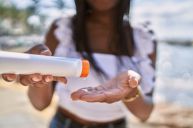Adeline Tonhaeuser is a 7-year-old girl who had her life turned upside down when she was only two. She suffers from a disorder called Congenital Erythropoietic Porphyria (CEP). This rare inherited disorder, originally thought of as a bug bite by her parents, forced Adeline to cover her entire skin with clothes, making it impossible for her to play with other kids during the day.
"Thinking it was nothing more than a simple bug bite, likely from the sandbox she was playing in, my husband and I didn't think anything more of it," reads a statement made by Megan and Kurt Tonhaeuser, Adeline's parents. Soon after, more blisters appeared on her skin, prompting them to visit their pediatrician.
At the time, said pediatrician prescribed some antibiotics, thinking that the issue was caused by impetigo, a contagious skin infection. However, they saw no improvement as more blisters continued to appear. That is when, on July 27, 2017, Megan and Kurt visited a pediatric dermatologist.
After the dermatologist ordered lab work and mentioned an assortment of possible conditions, Megan and Kurt felt overwhelmed. "We left the dermatologists office in a cloud of confusion, making sure we remembered exactly what she said but not understanding one word amid our disbelief," the couple said.
A Diagnosis No One Wanted To Hear
Amid their confusion, the family started researching CEP, one of the conditions mentioned by the dermatologist. Less than 300 cases have been documented in medical journals. "Finally, the dermatologist called and confirmed our worst fear. Adeline tested positive for Congenital Erythropoietic Porphyria," said Megan and Kurt in their statement.
They continue: "For the rest of Adeline's life - unless there is a cure for CEP - she will need to avoid UV light, not only from the sun, but also from artificial light." Both Megan and Kurt continue to protect Adeline's life at all costs.
CEP can become extremely dangerous for the affected. According to the National Organization for Rare Disorders (NORD): "After exposure to light, the photo-activated porphyrins in the skin cause bullae (blistering), the fluid-filled sacs rupture and the lesions often get infected. These infected lesions can lead to scarring, bone loss and deformities."




